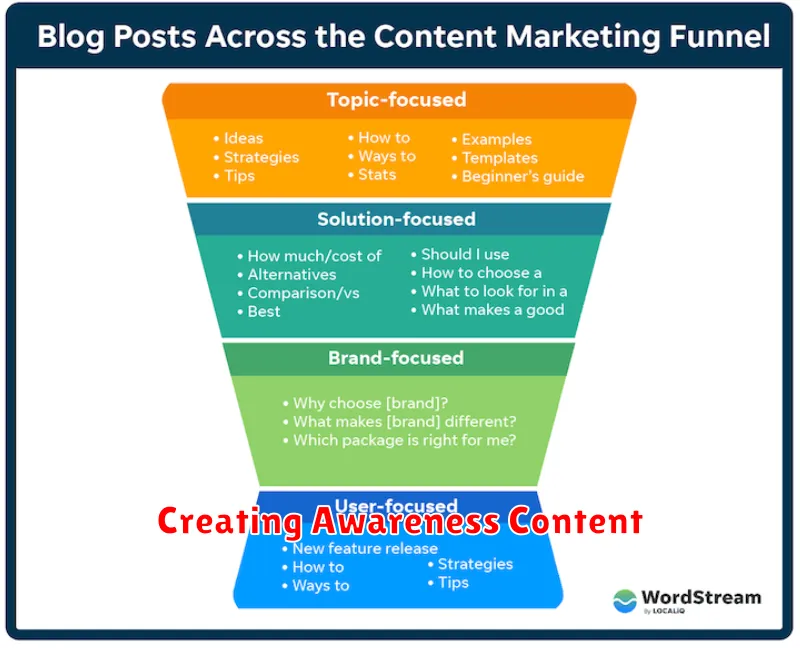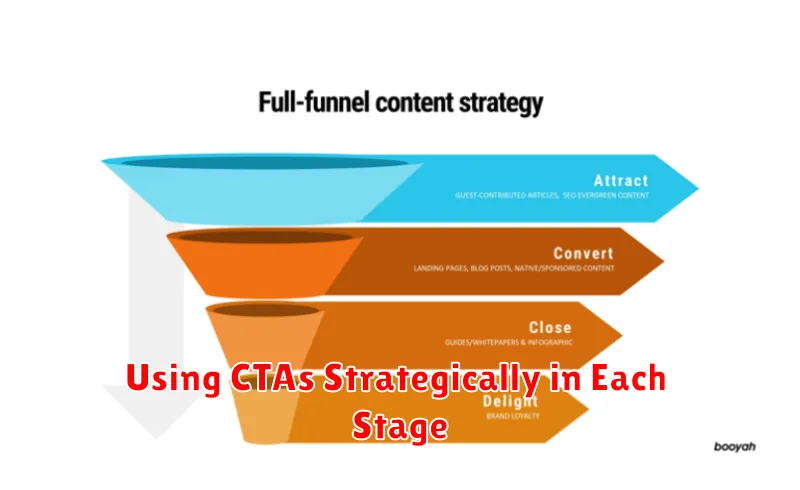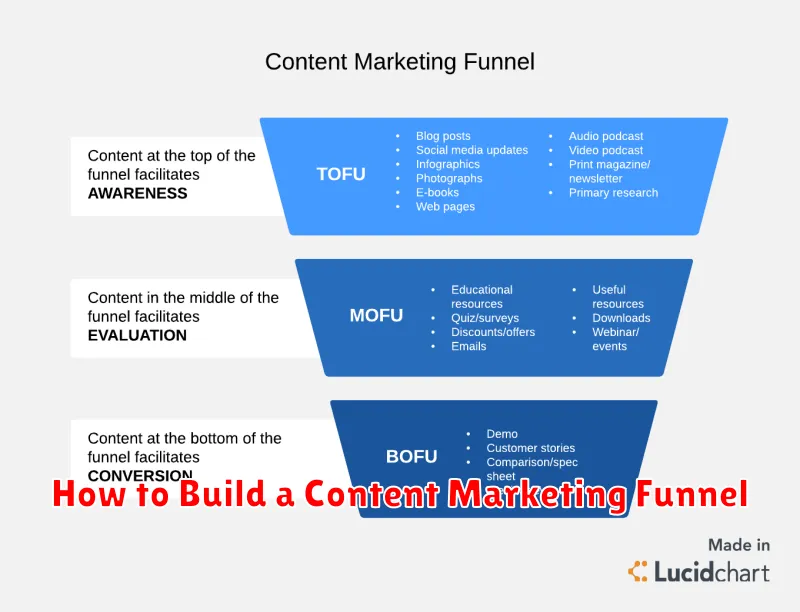In today’s digital landscape, a content marketing funnel is essential for attracting, engaging, and converting potential customers. This article provides a comprehensive guide on how to build a content marketing funnel that effectively guides your audience through each stage of the buyer’s journey, from initial awareness to final purchase. Understanding the core principles of a content marketing funnel and its strategic implementation is crucial for achieving your marketing objectives and driving business growth. By crafting targeted content for each stage, you can nurture leads and ultimately increase conversions.
Building a successful content marketing funnel requires a strategic approach, aligning content creation with the specific needs and interests of your target audience at each stage. This article will outline the key steps involved in constructing a high-performing content marketing funnel, including identifying your target audience, defining your content marketing goals, and selecting appropriate content formats for each stage. From attracting attention with engaging top-of-funnel content to nurturing leads with valuable middle-of-funnel resources and finally converting prospects with persuasive bottom-of-funnel offers, this guide will equip you with the knowledge to build a content marketing funnel that delivers tangible results.
Understanding Top, Middle, and Bottom Funnel Content
A content marketing funnel guides potential customers through the buying process using strategically crafted content. This process is often visualized as a funnel, widening at the top and narrowing towards the bottom, representing the decreasing number of prospects as they move closer to a purchase. Each stage requires different types of content tailored to the audience’s needs and level of engagement.
Top-of-funnel (TOFU) content focuses on attracting a broad audience and generating awareness about a problem or need. This content is typically educational and informative, addressing general pain points. Think blog posts, social media updates, and infographics.
Middle-of-funnel (MOFU) content targets prospects who have identified their problem and are actively searching for solutions. This stage nurtures leads by providing more in-depth information, such as ebooks, webinars, and case studies, showcasing your expertise and building trust.
Bottom-of-funnel (BOFU) content is designed to convert leads into paying customers. This content is highly specific and product-focused, including demos, free trials, and testimonials, helping prospects make informed purchase decisions.
Creating Awareness Content

The top of the funnel focuses on creating awareness and attracting a broad audience. Content at this stage should address general pain points and questions your target audience has, without explicitly promoting your product or service. The goal is to provide valuable information that positions your brand as a trusted resource.
Common formats for awareness content include blog posts, articles, infographics, and social media updates. These pieces should be easily digestible and optimized for discoverability through search engines and social media platforms.
Focus on topics relevant to your industry and audience. For example, if you sell project management software, you might create content about common project management challenges or tips for improving team productivity. This provides value to potential customers while subtly introducing them to your area of expertise.
Designing Consideration Content
The consideration stage is where potential customers have identified their problem and are actively researching solutions. Your content should help them understand how your product or service can address their specific needs. Focus on providing valuable information that showcases your expertise and builds trust.
Key content formats for this stage include:
- Case studies: Demonstrate successful implementations of your solution.
- Webinars and online events: Offer in-depth insights and opportunities for interaction.
- Comparison guides and white papers: Analyze different options available in the market, highlighting your advantages.
- Expert guides and how-to content: Empower potential customers with knowledge related to their challenges.
Remember to maintain a customer-centric approach, addressing their pain points and providing practical advice. Avoid overly promotional language; instead, focus on educating and informing your audience.
Crafting High-Converting Bottom Funnel Content
At the bottom of the funnel, your audience is ready to buy. Your content should focus on demonstrating value and overcoming final objections. This is where product-specific content truly shines.
Key content types for this stage include:
- Case studies: Showcase successful implementations and quantify results.
- Testimonials: Build trust by leveraging social proof and positive experiences from existing customers.
- Product demos and free trials: Allow potential customers to experience the product firsthand.
- Comparison charts: Highlight your competitive advantages and address specific customer needs.
- Pricing and packages information: Provide transparent and easy-to-understand pricing options.
The goal is to provide the final nudge needed to convert prospects into paying customers. Ensure your content is clear, concise, and focused on the benefits of choosing your product or service.
Mapping Content to the Buyer Journey
A key aspect of building a successful content marketing funnel is mapping your content to the different stages of the buyer’s journey. This ensures you’re providing the right information at the right time, nurturing leads towards conversion.
The buyer’s journey typically consists of three stages: awareness, consideration, and decision. Each stage requires different types of content tailored to the buyer’s specific needs and pain points.
In the awareness stage, the buyer is identifying a problem or need. Content should focus on educating the audience and providing general information related to their issue. Think blog posts, articles, and infographics.
During the consideration stage, the buyer is actively researching solutions. Content should offer more in-depth information, comparing different approaches and showcasing your expertise. Examples include white papers, case studies, and webinars.
Finally, in the decision stage, the buyer is ready to choose a solution. Content should focus on demonstrating the value of your product or service and making the purchase decision easy. Think testimonials, product demos, and free trials.
Using CTAs Strategically in Each Stage

Aligning your call to action (CTA) with the user’s position in the content marketing funnel is crucial for driving conversions. Each stage requires a different approach to effectively nurture leads.
Awareness Stage
At this stage, focus on providing valuable content and capturing interest. CTAs should be low-commitment, such as subscribing to a blog, downloading a free resource, or joining a webinar. The goal is to build trust and establish your expertise.
Consideration Stage
Prospects are now aware of their problem and researching solutions. Your CTAs should offer more specific information related to their needs, like product demos, case studies, or free consultations. These CTAs help position your offering as a potential solution.
Decision Stage
Users are ready to buy. CTAs should be direct and action-oriented, prompting them to make a purchase, request a quote, or sign up for a trial. Examples include “Buy Now,” “Get a Quote,” or “Start Your Free Trial.”
Action Stage
After a purchase, CTAs shift towards customer retention and advocacy. Encourage reviews, offer exclusive content, or promote loyalty programs. This stage focuses on building long-term relationships and turning customers into brand ambassadors.
Tracking Funnel Performance
Regular monitoring of your content marketing funnel’s performance is crucial for optimization and achieving desired results. Tracking key metrics allows you to identify bottlenecks, understand user behavior, and refine your strategy.
Key metrics to track include:
- Awareness: Website traffic, social media reach, and brand mentions.
- Interest: Content downloads, time spent on page, and email sign-ups.
- Decision: Demo requests, free trial sign-ups, and sales calls.
- Action: Purchases, subscriptions, and customer lifetime value.
Analyze these metrics across different stages of the funnel to pinpoint areas for improvement. For instance, if you see a drop-off between interest and decision, it might indicate a need for stronger calls to action or more compelling content at that stage.

